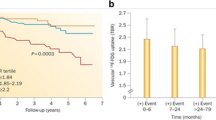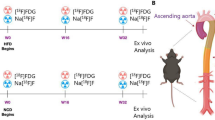Abstract
Background
Fluorine 18 fluorodeoxyglucose (FDG) has been shown to accumulate in inflamed tissues. However, it is not known whether vascular inflammation can be measured noninvasively. The aim of this study was to test the hypothesis that vascular inflammation can be measured noninvasively by use of positron emission tomography (PET) with FDG.
Methods and Results
Inflamed atherosclerotic lesions were induced in 9 male New Zealand white rabbits via balloon injury of the aortoiliac arterial segment and exposure to a high cholesterol diet. Ten rabbits fed standard chow served as controls. Three to six months after balloon injury, the rabbits were injected with FDG (1 mCi/kg), after which aortic uptake of FDG was assessed (3 hours after injection). Biodistribution of FDG activity within aortic segments was obtained by use of standard well gamma counting. FDG uptake was also determined noninvasively in a subset of 6 live atherosclerotic rabbits and 5 normal rabbits, via PET imaging and measurement of standardized uptake values over the abdominal aorta. Plaque macrophage density and smooth muscle cell density were determined by planimetric analysis of RAM-11 and smooth muscle actin staining, respectively. Biodistribution of FDG within nontarget organs was similar between atherosclerotic and control rabbits. However, well counter measurements of FDG uptake were significantly higher within atherosclerotic aortas compared with control aortas (P <.001). Within the upper abdominal aorta of the atherosclerotic group (area of greatest plaque formation), there was an approximately 19-fold increase in FDG uptake compared with controls (108.9 ± 55.6 percent injected dose [%ID]/g × 103 vs 5.7 ± 1.2 %ID/g × 103 [mean ± SEM], P <.001). In parallel with these findings, FDG uptake, as determined by PET, was higher in atherosclerotic aortas (standardized uptake value for atherosclerotic aortas vs control aortas, 0.68 ± 0.06 vs 0.13 ± 0.01; P <.001). Moreover, macrophage density, assessed histologically, correlated with noninvasive (PET) measurements of FDG uptake (r = 0.93, P <.0001). In contrast to this finding, FDG uptake did not correlate with either aortic wall thickness or smooth muscle cell staining of the specimens.
Conclusion
These data show that FDG accumulates in macrophage-rich atherosclerotic plaques and demonstrate that vascular macrophage activity can be quantified noninvasively with FDG-PET. As such, measurement of vascular FDG uptake with PET holds promise for the noninvasive characterization of vascular inflammation.
Similar content being viewed by others
References
Corstens FH, van der Meer JW. Nuclear medicine’s role in infection and inflammation. Lancet 1999;354:765–70.
Rubin RH, Fischman AJ, Callahan RJ, Khaw BA, Keech F, Ahmad M, et al. 111In-labeled nonspecific immunoglobulin scanning in the detection of focal infection. N Engl J Med 1989;321:935–40.
Hunter GJ, Hamberg LM, Alpert NM, Choi NC, Fischman AJ. Simplified measurement of deoxyglucose utilization rate. J Nucl Med 1996;37:950–5.
Palmer WE, Rosenthal DI, Schoenberg OI, Fischman AJ, Simon LS, Rubin RH, et al. Quantification of inflammation in the wrist with gadolinium-enhanced MR imaging and PET with 2-[F-18]-fluoro-2-deoxy-D-glucose. Radiology 1995;196:647–55.
Goldberg MA, Mayo-Smith WW, Papanicolaou N, Fischman AJ, Lee MJ. FDG PET characterization of renal masses: preliminary experience. Clin Radiol 1997;52:510–5.
Goldberg MA, Lee MJ, Fischman AJ, Mueller PR, Alpert NM, Thrall JH. Fluorodeoxyglucose PET of abdominal and pelvic neoplasms: potential role in oncologic imaging. Radiographics 1993;13:1047–62.
Fischman AJ, Thornton AF, Frosch MP, Swearinger B, Gonzalez RG, Alpert NM. FDG hypermetabolism associated with inflammatory necrotic changes following radiation of meningioma. J Nucl Med 1997;38:1027–9.
Kubota R, Kubota K, Yamada S, Tada M, Ido T, Tamahashi N. Microautoradiographic study for the differentiation of intratumoral macrophages, granulation tissues and cancer cells by the dynamics of fluorine-18-fluorodeoxyglucose uptake. J Nucl Med 1994;35:104–12.
Kaim AH, Weber B, Kurrer MO, Gottschalk J, Von Schulthess GK, Buck A. Autoradiographic quantification of 18F-FDG uptake in experimental soft-tissue abscesses in rats. Radiology 2002;223:446–51.
Sugawara Y, Braun DK, Kison PV, Russo JE, Zasadny KR, Wahl RL. Rapid detection of human infections with fluorine-18 fluorodeoxyglucose and positron emission tomography: preliminary results. Eur J Nucl Med 1998;25:1238–43.
Yamada S, Kubota K, Kubota R, Ido T, Tamahashi N. High accumulation of fluorine-18-fluorodeoxyglucose in turpentineinduced inflammatory tissue. J Nucl Med 1995;36:1301–6.
Babior BM. The respiratory burst of phagocytes. J Clin Invest 1984;73:599–601.
Libby P. Coronary artery injury and the biology of atherosclerosis: inflammation, thrombosis, and stabilization. Am J Cardiol 2000; 86:3J-9J.
Seshiah PN, Kereiakes DJ, Vasudevan SS, Lopes N, Su BY, Flavahan NA, et al. Activated monocytes induce smooth muscle cell death: role of macrophage colony-stimulating factor and cell contact. Circulation 2002;105:174–80.
Tatsumi M, Cohade C, Nakamoto Y, Wahl RL. Fluorodeoxyglucose uptake in the aortic wall at PET/CT: possible finding for active atherosclerosis. Radiology 2003;229:831–7.
Lederman RJ, Raylman RR, Fisher SJ, Kison PV, San H, Nabel EG, et al. Detection of atherosclerosis using a novel positronsensitive probe and 18-fluorodeoxyglucose (FDG). Nucl Med Commun 2001;22:747–53.
Rudd JH, Warburton EA, Fryer TD, Jones HA, Clark JC, Antoun N, et al. Imaging atherosclerotic plaque inflammation with [18F]- fluorodeoxyglucose positron emission tomography. Circulation 2002;105:2708–11.
Ogawa M, Ishino S, Mukai T, Asano D, Teramoto N, Watabe H, et al. 18F-FDG accumulation in atherosclerotic plaques: immunohistochemical and PET imaging study. J Nucl Med 2004;45:1245–50.
Meller J, Altenvoerde G, Munzel U, Jauho A, Behe M, Gratz S, et al. Fever of unknown origin: prospective comparison of [18F]FDG imaging with a double-head coincidence camera and gallium-67 citrate SPET. Eur J Nucl Med 2000;27:1617–25.
Vallabhajosula S, Fuster V. Atherosclerosis: imaging techniques and the evolving role of nuclear medicine. J Nucl Med 1997;38:1788–96.
Mari C, Nedelman M, Blankenberg F, Ghazarossian V, Strauss RW. Detection of active atheroma in a rabbit model: evaluation of 8 radiotracers. J Nucl Med 2001;42:38.
Vallabhajosula S, Machac J, Knesaurek K, et al. Imaging atherosclerotic macrophage density by positron emission tomography using F-18-fluorodeoxyglucose [abstract]. J Nucl Med 1996;37:38.
Fischman AJ, Lees AM, Lees RS, Barlai-Kovach M, Strauss HW. Accumulation of native and methylated low density lipoproteins by healing rabbit arterial wall. Arteriosclerosis 1987;7:361–6.
Strauss L, Conti P. The applications of PET in clinical oncology. J Nucl Med 1991;32:623–48.
Corti R, Ferrari C, Roberti M, Alerci M, Pedrazzi PL, Gallino A. Spiral computed tomography: a novel diagnostic approach for investigation of the extracranial cerebral arteries and its complementary role in duplex ultrasonography. Circulation 1998;98:984–9.
Jander S, Sitzer M, Schumann R, Schroeter M, Siebler M, Steinmetz H, et al. Inflammation in high-grade carotid stenosis: a possible role for macrophages and T cells in plaque destabilization. Stroke 1998;29:1625–30.
Jones HA, Cadwallader KA, White JF, Uddin M, Peters AM, Chilvers ER. Dissociation between respiratory burst activity and deoxyglucose uptake in human neutrophil granulocytes: implications for interpretation of (18)F-FDG PET images. J Nucl Med 2002;43:652–7.
Sugawara Y, Gutowski TD, Fisher SJ, Brown RS, Wahl RL. Uptake of positron emission tomography tracers in experimental bacterial infections: a comparative biodistribution study of radiolabeled FDG, thymidine, L-methionine, 67Ga-citrate, and 125IHSA. Eur J Nucl Med 1999;26:333–41.
Lorenzen J, Buchert R, Bohuslavizki KH. Value of FDG PET in patients with fever of unknown origin. Nucl Med Commun 2001;22:779–83.
Hunter GJ, Choi NC, McLoud TC, Fischman AJ. Lung tumor metastasis to breast detected by fluorine-18-fluorodeoxyglucose PET. J Nucl Med 1993;34:1571–3.
Newsholme P, Newsholme EA. Rates of utilization of glucose, glutamine and oleate and formation of end-products by mouse peritoneal macrophages in culture. Biochem J 1989;261:211–8.
Rist RJ, Jones GE, Naftalin RJ. Effects of macrophage colonystimulating factor and phorbol myristate acetate on 2-D-deoxyglucose transport and superoxide production in rat peritoneal macrophages. Biochem J 1991;278 (Pt 1):119–28.
Kiyotaki C, Peisach J, Bloom BR. Oxygen metabolism in cloned macrophage cell lines: glucose dependence of superoxide production, metabolic and spectral analysis. J Immunol 1984;132:857–66.
Ahmed N, Kansara M, Berridge MV. Acute regulation of glucose transport in a monocyte-macrophage cell line: Glut-3 affinity for glucose is enhanced during the respiratory burst. Biochem J 1997;327(Pt 2):369–75.
Berridge MV, Tan AS. Interleukin-3 facilitates glucose transport in a myeloid cell line by regulating the affinity of the glucose transporter for glucose: involvement of protein phosphorylation in transporter activation. Biochem J 1995;305(Pt 3):843–51.
Pasternak CA, Aiyathurai JE, Makinde V, Davies A, Baldwin SA, Konieczko EM, et al. Regulation of glucose uptake by stressed cells. J Cell Physiol 1991;149:324–31.
Bashan N, Burdett E, Hundal HS, Klip A. Regulation of glucose transport and GLUT1 glucose transporter expression by O2 in muscle cells in culture. Am J Physiol 1992;262(Pt 1):C682–90.
Nefesh I, Bauskin AR, Alkalay I, Golembo M, Ben-Neriah Y. IL-3 facilitates lymphocyte hexose transport by enhancing the intrinsic activity of the transport system. Int Immunol 1991;3:827–31.
Hara M, Goodman PC, Leder RA. FDG-PET finding in earlyphase Takayasu arteritis. J Comput Assist Tomogr 1999;23:16–8.
Blockmans D, Maes A, Stroobants S, Nuyts J, Bormans G, Knockaert D, et al. New arguments for a vasculitic nature of polymyalgia rheumatica using positron emission tomography. Rheumatology (Oxford) 1999;38:444–7.
Derdelinckx I, Maes A, Bogaert J, Mortelmans L, Blockmans D. Positron emission tomography scan in the diagnosis and follow-up of aortitis of the thoracic aorta. Acta Cardiol 2000;55:193–5.
Ridker PM. Inflammation, atherosclerosis, and cardiovascular risk: an epidemiologic view. Blood Coagul Fibrinolysis 1999;10(Supp1):S9-S12.
Plutzky J. Atherosclerotic plaque rupture: emerging insights and opportunities. Am J Cardiol 1999;84:15J-20J.
Davies MJ, Thomas A. Thrombosis and acute coronary-artery lesions in sudden cardiac ischemic death. N Engl J Med 1984;310:1137–40.
Davies MJ, Woolf N, Rowles P, Richardson PD. Lipid and cellular constituents of unstable human aortic plaques. Basic Res Cardiol 1994;89(Suppl 1):33–9.
Davies MJ. Acute coronary thrombosis-the role of plaque disruption and its initiation and prevention. Eur Heart J 1995; 16(Suppl 1):3–7.
Burke AP, Farb A, Malcom GT, Liang YH, Smialek J, Virmani R. Coronary risk factors and plaque morphology in men with coronary disease who died suddenly. N Engl J Med 1997;336:1276–82.
Farb A, Burke AP, Tang AL, Liang TY, Mannan P, Smialek J, et al. Coronary plaque erosion without rupture into a lipid core. A frequent cause of coronary thrombosis in sudden coronary death. Circulation 1996;93:1354–63.
Kolodgie FD, Burke AP, Farb A, Gold HK, Yuan J, Narula J, et al. The thin-cap fibroatheroma: a type of vulnerable plaque: the major precursor lesion to acute coronary syndromes. Curr Opin Cardiol 2001;16:285–92.
Golledge J, Cuming R, Ellis M, Davies AH, Greenhalgh RM. Carotid plaque characteristics and presenting symptom. Br J Surg 1997;84:1697–701.
Virmani R, Farb A, Burke AP. Risk factors in the pathogenesis of coronary artery disease. Compr Ther 1998;24:519–29.
Libby P. What have we learned about the biology of atherosclerosis? The role of inflammation. Am J Cardiol 2001;88:3J-6J.
Galis ZS, Khatri JJ. Matrix metalloproteinases in vascular remodeling and atherogenesis: the good, the bad, and the ugly. Circ Res 2002;90:251–62.
Tawakol A, Skopicki HA, Abraham SA, Alpert NM, Fischman AJ, Picard MH, et al. Evidence of reduced resting blood flow in viable myocardial regions with chronic asynergy. J Am Coll Cardiol 2000;36:2146–53.
Melon PG, de Landsheere CM, Degueldre C, Peters JL, Kulbertus HE, Pierard LA. Relation between contractile reserve and positron emission tomographic patterns of perfusion and glucose utilization in chronic ischemic left ventricular dysfunction: implications for identification of myocardial viability. J Am Coll Cardiol 1997;30:1651–9.
Gerber BL, Vanoverschelde JL, Bol A, Michel C, Labar D, Wijns W, et al. Myocardial blood flow, glucose uptake, and recruitment of inotropic reserve in chronic left ventricular ischemic dysfunction. Implications for the pathophysiology of chronic myocardial hibernation. Circulation 1996;94:651–9.
Author information
Authors and Affiliations
Additional information
This study was supported in part by grants from the Center for Integration of Medicine and Innovative Technology (A.T.), National Institutes of Health (NIH) RR16046 (A.T.), and NIH EB02102E20 (R.Q.M.).
Rights and permissions
About this article
Cite this article
Tawakol, A., Migrino, R.Q., Hoffmann, U. et al. Noninvasive in vivo measurement of vascular inflammation with F-18 fluorodeoxyglucose positron emission tomography. J Nucl Cardiol 12, 294–301 (2005). https://doi.org/10.1016/j.nuclcard.2005.03.002
Issue Date:
DOI: https://doi.org/10.1016/j.nuclcard.2005.03.002




